Expert Made Available
Every morning, that first glance at your email is a concession and a gamble. It is a concession that this day will proceed in the manner of ___days past, and that you agree to deal with whatever shows up in your inbox, either by consciously engaging with it or consciously ignoring it; it is a simple wager that nothing too horrible has arrived since you last checked. A good gambler would look at the inbox (Unread: 1,642) and see only downside. And yet the tab stays open. And this morning:
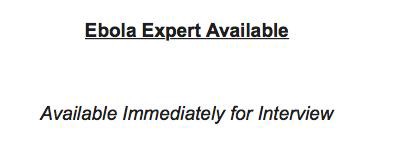
Good morning and welcome to the first full week of August.
This Week in Lines
by Jake Gallagher
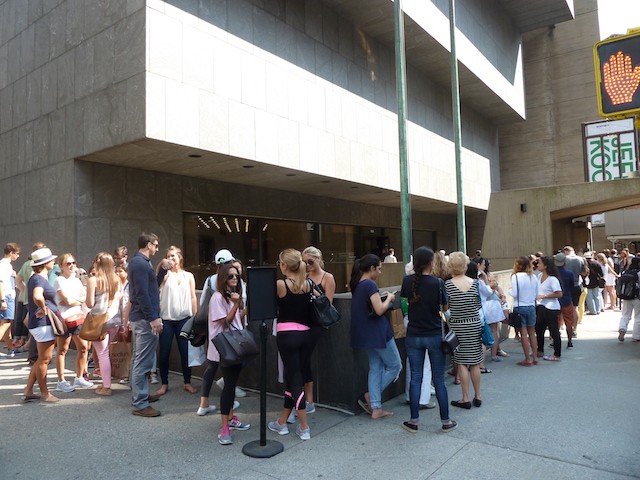
Jeff Koons Retrospective, The Whitney — July 25th, 4:06PM
Location: 75th St. and 5th Ave.
Length: 68 people
Weather: 81 and partly cloudy
Crowd: Diverse enough to make any Koons collector (and their wallet) swell with pride.
Mood: A despondent tourist whined to her friends. A native clutching an “I *insert giant ballon rabbit* Koons” tote smirked as she took her place at the back of the line.
Wait Time: 30–45 minutes
Lingering Question: How many visitors does it take to raise the value of a Jeff Koons work by one percent?
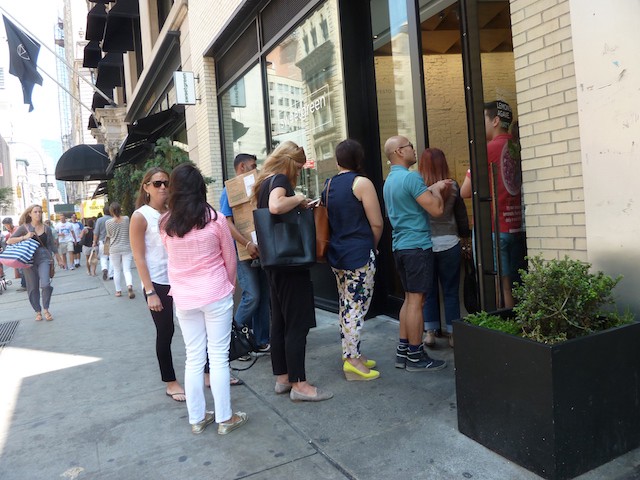
Sweetgreen, Nomad — July 25th, 12:24PM
Location: Broadway between 27th St. and 28th St.
Length: 8 people outside, 38 inside and ever growing
Weather: 79 and mostly sunny
Crowd: Sundressed women and bearded men. Only two people over the age of forty-five.
Mood: Jittery yet pleasant. No one would dare disrupt the Sweetgreen’s sacred organic order.
Wait Time: 17 minutes.
Lingering Question: How many calories of that salad do you burn while waiting in line?
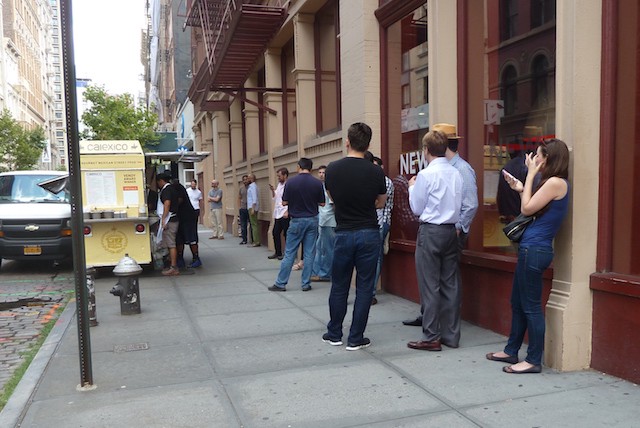
Calexico Cart — July 28th, 12:21PM
Location: Wooster and Prince
Length: 18 people
Weather: 75 and cloudy
Crowd: 16 men, 2 women, and 18 iPhones.
Mood: Calculated distraction
Wait Time: 12 minutes.
Lingering Question: How many times can you re-read the same tweets before you finally get bored enough to look up and risk human interaction?
Jake Gallagher is a writer for A Continuous Lean and other places.
New York City, July 31, 2014
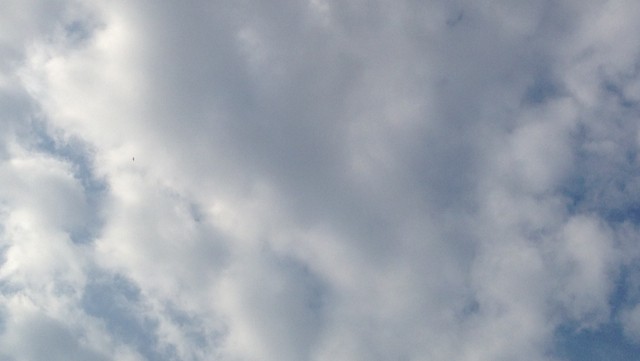
★★★★ Destabilized, opening the gates for the fall from paradise. Dark gray filled the sky to the west, while the sun fought through clouds in the east. Humidity was up; the air conditioning on again. People were engrossed in their devices. A few raindrops fell along the way to the office. Then the sun rallied: light traced the old painted scrollwork on the fire escapes and the new shiny ridges on the air-conditioner cages. It shone through the primaries of a pigeon banking over Grand Street. A damp wind rippled the stained rainbow umbrellas of the fruit vendors. The afternoon air had a thick and stuffy note, compared to the distilled perfection that had come before. Heavy yellow-gray clouds moved along the zenith, with deep blue in the gaps between them. They threatened to mean something but didn’t, or at least they meant nothing so simple and intelligible as a punctuating rain.
What a Pack of Cigarettes Costs, State By State
by Noah Kulwin
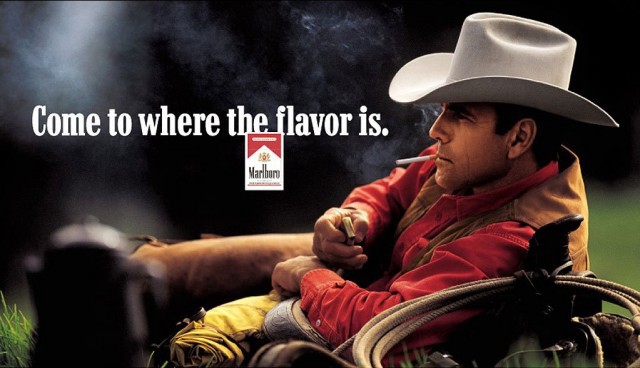
Every year, we check the prices of cigarettes in all fifty legally recognized states of this fair Union. (See what a pack of cigarettes costs in 2015 here; previously: 2013, 2012, 2011.) Predictably, the results are mostly — but not entirely! — grim: for the first time in the short history of this survey, not a single store in any state state offered us a pack of cigarettes for less than five dollars. So do smoke them, if you happen to have them, since nothing is ever going to get better.
This year, reigning affordable tobacco merchant Kentucky was resoundingly knocked out of the top spot; four states now offer cheaper cigarettes. If obtaining the cheapest possible cigarettes from nearby convenience stores is the overriding factor in the choice of your domicile’s location, you can set your Google Maps coordinates for Virginia or Missouri. While New York and Illinois both offer some relief, they manage to retain their position as the states where cigarettes are most likely to cause you to bounce your rent check. Also of note: Oklahoma cigarettes cost 21 percent more this year than last, and Minnesota’s are up by 36 percent.
As for where these numbers come from: we called convenience stores and gas stations in the most highly populated areas of each state (obvious disclaimer: prices aren’t the same in every store in every area), and asked politely for the cost of a pack of Marlboro Red cigarettes. The current price is in bold; last summer’s price is in parentheses. As always, YMMV.
48. Virginia (last year -$5.81), Missouri ($5.25): $5.25 = -10%, +0%
47. Tennessee ($5.89): $5.30 = -10%
46. North Dakota ($5.04): $5.33 = -6%
45. Kentucky ($4.96): $5.40 = +9%
44. Wyoming ($5.37), Idaho ($5.25): $5.41 = +.01%, +3%
43. West Virginia ($5.07): $5.43 = +7%
42. Louisiana ($5.33): $5.44 = +2%
41. North Carolina ($6.03): $5.45 = -10%
40. Alabama ($5.80): $5.51 = -5%
39. South Carolina ($5.55): $5.58 = +.01%
38. Colorado ($5.59): $5.65 = +1%
37. Oregon ($5.35): $5.69 = +6%
36. Kansas ($6.21): $5.83 = -6%
35. California ($6.77): $5.89 = -13%
34. Indiana ($5.77): $5.97 = +4%
33. Ohio ($5.88): $6.03 = +3%
32. Arkansas ($6.50): $6.07 = -7%
31. South Dakota ($6.77): $6.08 = -10%
30. Nevada ($5.50): $6.15 = +12%
29. Nebraska ($6.09): $6.23 = +2%
28. Oklahoma ($5.19), Iowa ($7.25): $6.29 = +21%, -13%
27. Florida ($6.00): $6.30 = +5%
26. Mississippi ($5.45): $6.34 = +16%
25. Delaware ($6.00): $6.35 = +6%
24. Georgia ($5.93): $6.39 = +8%
23. New Hampshire ($6.59): $6.44 = -2%
22. Montana ($6.25): $6.46 = +3%
21. Texas ($7.24): $6.69 = -8%
20. Pennsylvania ($6.95): $6.85 = -1%
19. Utah ($6.64): $6.89 = +4%
18. Maine ($7.12): $7.37 = +4%
17. New Mexico ($6.91): $7.67 = +11%
16. Maryland ($7.93): $7.75 = -2%
15. D.C. ($7.89): $7.99 = +1%
14. Michigan ($6.95): $8.00 = +15%
13. Arizona ($9.65): $8.05 = -17%
12. Minnesota ($5.95): $8.10 = +36%
11. New Jersey ($8.55): $8.20 = -4%
10. Wisconsin ($8.11): $8.82 = +9%
9. Rhode Island ($9.56): $8.95 = -6%
8. Washington ($8.31): $9.30 = +12%
7. Connecticut ($9.30): $9.52 = +2%
6. Hawaii ($9.68): $9.55 = -1%
5. Vermont ($9.52): $9.62 = +1%
4. Alaska ($9.59): $9.79 = +2%
3. Massachusetts ($8.77): $9.95 = +13%
2. Illinois ($11.59): $11.50 = -.01%
1. New York ($14.50): $12.85 = -11%
Noah Kulwin is The Awl’s summer data journalism fellow.
Never Ever Ever (Ever) Get Lost Again With Hertz NeverLost
by Awl Sponsors
Brought to you by Hertz
If you’re like the average car renter, chances are you usually skip paying for the GPS option and instead rely on your handy smartphone. However, this new video from Hertz illustrates why a smartphone might just not cut it. Whether it’s spotty service reception, the extreme battery drain, or those unexpected data charges that we’ve all encountered, you’ll want to think twice about substituting on your next car rental. .
At Hertz, they’ve created NeverLost, an incredible service that’s unlike any GPS or app out there. Why? Because you can plan your entire trip online and get a four-digit code to plug into the device. And if you’re feeling lazy, you can simply call their live concierge team directly for a customized preloaded USB with all of your trip destinations programmed in and shipped to you to at no cost.
With Hertz NeverLost, you’ll drive a whole lot safer and a whole lot smarter! Learn more about NeverLost here.
A Guide to Visiting Iceland on July 16th, 2014
by Emmet Stackelberg
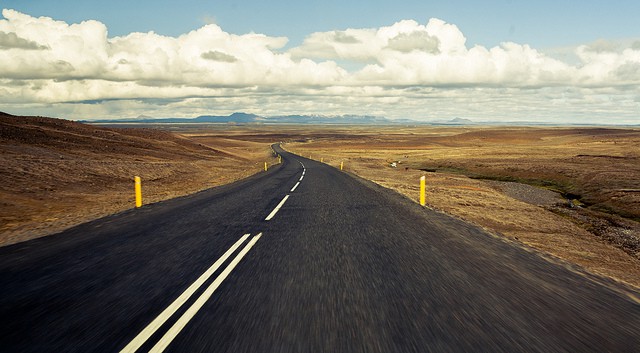
Your day in Iceland begins on a bus, the Flybus, which shuttles along Iceland’s edge from Keflavik airport to Reykjavik. In ten years, you might be able to do this trip on a train that will carry a thousand passengers every hour. Iceland has never had a public train before, so it’s possible that the first public train in Iceland will cater almost exclusively to tourists, whose numbers are projected to almost double by 2023.
Until then, it’s the Flybus, which traces a boundary between Atlantic Ocean and an inexplicable, bulbous network of volcanic rock. Observe as you travel that the treeless terrain, at once both traversable and inhospitable, makes it perfect for video game realms where characters can only move, jump, and shoot. Travel fact: Ridley Scott’s upcoming movie version of Halo just filmed in Iceland a few weeks ago.
Reykjavik is a driving city — a small Los Angeles, you will be told, with growing traffic problems. The traffic gets worse as the city gets bigger, in large part because of tourism — because of all the hotels they’re building. But still, we’re talking a really small LA, since its population is just a bit over a hundred and two thousand people. After stopping by a hideous cement church, a hot dog stand, and the shopping district, you will finish your city tour in forty-five minutes.
Now it’s time to see some of Iceland’s famous wilderness. Rent a car with a friend to go watch a performance of Cage’s 4:33 in an ancient ravine. Pile in with another guy and two girls you just met. One of them is best friends with that girl from your high school, which is the sort of improbability that you can still fathom, like the fact that all the water in Iceland smells vaguely of sulfur. Travel fact: that girl from high school had blond hair and responded to something you’d say with a scoff and a smirk and that either meant she disapproved or didn’t understand — you never figured out which. You spoke little to her and she to you. And now you and her best friend are careening across a well-marketed arctic landmass, united by that foreign visitor spirit, that desire for exotic curiosities and safe adventures.
Arrive, suddenly, at a ravine, a gash in the earth so vast it hosts a waterfall from which they used to hurl women accused of adultery. Travel fact: adulterous men were hanged from the edge of the ravine. No number of imagined self-deaths will help you decide which gender had it worse.
Look across the ravine, at land that pushes itself apart. The line of the Eurasian plate and North American plates is right there, where you can see it. But while the land recedes from you, the sky appears to careen toward you. You’re making this drive at midnight and the sun’s still up, seeming to you, a man from the temperate zone, like a mistake of the universe.
Watch out for the bugs. They’re all over. Later, your friend will show you some footage he shot for a documentary he’s working on. It shows a woman yacking it because too many bugs flew in her mouth. Contemplating that many bugs is a challenge for you, but part of the fun of travel is the challenge.
Make too many jokes with your fellow adventurers, unsure of why you’re making them. Maybe because you’re tired and your body is confused, or maybe because the notion of unsetting suns and ancient human ritual outdone by more ancient geological inevitability brings out an awful dread in you. You want to mask this bizarre feeling, one you figure Icelanders must’ve gotten over thousands of years ago. It’s probably what makes them so nice, so crimeless, so etc.
Learn, via Facebook (events) and Google (translate), that you missed the Cage thing by hours. At some point, 20:00 had become 18:00. Easy to do in a land that seems to disobey time. You have other things to explore, like an ancient dueling ground now ruled by a fiefdom of protective geese, and a moss-covered hill overlooking a misty, mysterious lake. Travel fact: you will only learn after you step on the moss that you’re royally fucking with the biome and ruining a bunch of little lives as significant to you as yours is to the shifting tectonic plates beneath you. This will be told to you in the form of, “Yeah, we really shouldn’t be walking on this moss.” Your emotional response to this will be almost volcanic — a sudden, obliterating sadness. Why, when this place so amazes you so, did you wreck a little piece of it?
Travel facts: a geological instant ago, just before the Vikings stumbled across it, a quarter of Iceland was covered by birch forest. The first Viking settlers destroyed that forest. The old growth probably helped build structures and maybe even ships, and the newer, stubby growth that replaced it got thrown into vast pits to create charcoal for the iron forges. And so we got deforestation and desertification and Halo terrain. No pesky trees to render. Less than one percent of present-day Iceland is birch forest. The passage of that geological instant has not, on the whole, changed us. Humans continue to be unsurpassed, even by volcanos, in our capacity to annihilate. According to Greenpeace, between 1996 and 2006, loggers in the Amazon rainforest deforested an area about the size of Iceland.
You’ll find all this out a few days later, though. Right now, you’re still freaking out about the moss. You can’t explain why and you don’t think your friend or the other riders or that girl from your high school or the traditional phrases sewn into your Icelandair blankets or the map of the forbidden driving zone in the Subaru’s glove box or the Vikings or any living thing could clarify it, either. The closest you will get to explaining anything comes when all of you, together, stop on the walk back to the car and watch a cloud slowly, so slowly, move across a mountain. You will do this in total silence. Altogether you reenact 4:33 about three times, just standing there, in awe or in deep focus or just lost. The land in that moment needs no interpretation, no advocacy, certainly no alteration. At least, you think. You’re still really jet lagged, of course, and you have an early Flybus to catch in the morning.
Emmet von Stackelberg is a writer living in Cambridge.
Photo by Matteo Sorba
When Lights Are Low In London
“SCARED residents are snapping up stab proof vests and protective clothing to shield themselves from attacks during the street light switch-off, an Essex defence company boss claims.”
The Big Blue Bottle Machine
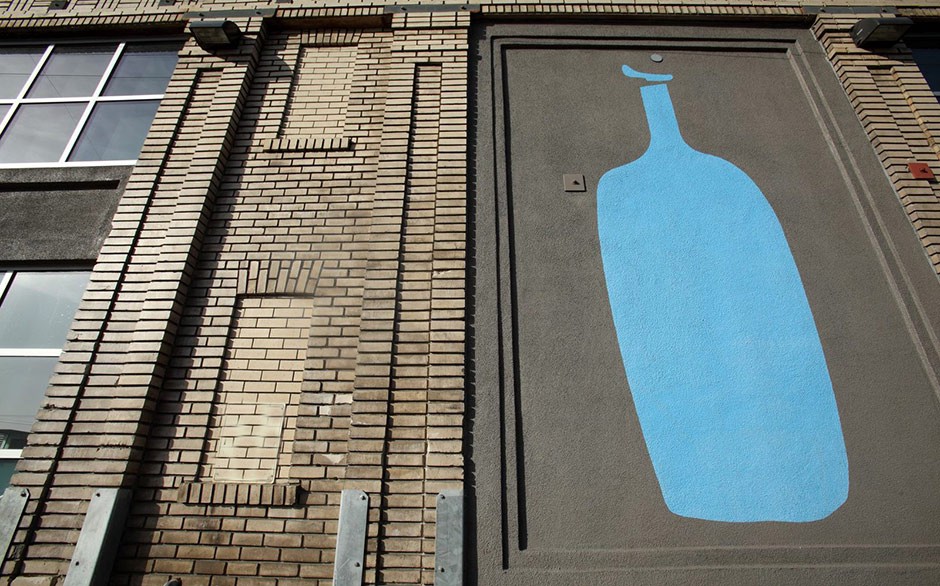
There are at least two things to say with regards to Alexis Madrigal’s long ode to the processes that have produced both coffee’s shiniest monolith, Blue Bottle, and its newish adorable milk cartons filled with coffee, chicory, milk and sugar.
While it’s only a tiny moment in the piece, Madrigal hits on precisely what has propelled Blue Bottle beyond its specialty coffee peers in the public imagination (and investors’ hearts):
But going into our interview, what I found most interesting about [James Freeman], and a defining trait of Blue Bottle’s business maneuverings, is that he considers all the micropsychological conditions that someone might be in as they enter a cafe. “Sometimes people go out for their first coffee of the day and that’s a very vulnerable time in someone’s life, while they’re waiting for that first cup of coffee,” he told the Food Seen podcast, for example.
Until recently, within the higher rungs of the specialty coffee industry, it has been extremely fashionable to have barely disguised disdain for the quality of Blue Bottle’s actual coffee — it’s so open that it just barely stays inside the line of being an open secret (go ahead, ask your favorite barista!) — but it’s hard to find someone who would dispute that in terms of the entire coffee experience, Blue Bottle has been largely unparalleled. (G & B in L.A. is doing interesting things in this regard.) Blue Bottle’s stores are beautiful and inviting; its baristas are generally unscowly and accommodating; its coffee is fine (most would agree that it has gotten notably better in the last year). If you didn’t wait for an hour, you walk out of Blue Bottle probably feeling fantastic about life, which is not always true of the places that serve the actual best coffee. That’s because Freeman cares as much, if not more, about how you feel than what you taste.
It’s unsurprising that Blue Bottle is the first of the current milieu of flagship specialty coffee companies — your Counter Cultures, Stumptowns and Intelligentsias — to engineer a genuinely delicious mass-produced cold coffee beverage for precisely that reason: It has always cared less about pushing things like origin and the terroir of coffee on its customers than its peers have; it cares about what people will enjoy. And people enjoy coffee mixed with milk and sugar and spices, because it’s delicious. Conveniently, the milk and sugar provide artful, robust camouflage against defects that might arise in the coffee, which must remain shelf stable in grocery-store coolers for weeks on end; most coffee guides suggest that cold brew, even kept in a fridge, is past its peak after just two weeks. So it’s no wonder that a Blue Bottle milk carton is going to taste better than straight black coffee from a Stumptown Stubbie (which I’ve always found, even after three years, often taste no better than cheap, shitty-delicious Japanese canned coffee that carries none of the pretense?). No wonder, perhaps, that Stumptown also sells its own milk cartons — which I bet taste just as delicious as Blue Bottle’s.
A Poem by Sara Sutter
by Mark Bibbins, Editor
The Changing Snow Chicken
A type of grouse. A game bird whose
name originates from imitation
of all the grumbling he does — “his
song is more like a croak” — thus few souls go
within earshot. The Changing Snow
Chicken lives in the Arctic and changes
“from brown in summer to a nice
winter plumage in winter.” “Naturally,”
he explains, “this helps me blend in-
to my environment, which I refuse
to leave although it’s the harshest
tundra on the planet.” This, he tells you
while wagging his comb — his sole
ornament, big as a half-closed fist —
Sara Sutter wrote a chapbook, Sirenomelia, published by Poor Claudia. Her poems and essays appear in Bayou, Fence, Windsor Review and various artisan journals.
You will find more poems here. You may contact the editor at poems@theawl.com.
The Subway Train I Would Not Ride
If I had to choose one subway train to not ride, I’d not ride the 2 train. After researching more than twenty subway lines and testing six measures of performance, the Straphangers Campaign found that that the 2 was the one train that its panel could agree on was the worst. It’s not perfectly awful — although it scored below average on “regularity of service,” “delays caused by mechanical breakdowns,” and “seat availability during rush hour.” It fortunately tied for best in the system on subway car announcements. However, it is pretty bad, and of all the trains, it is the one that I would not ride.
